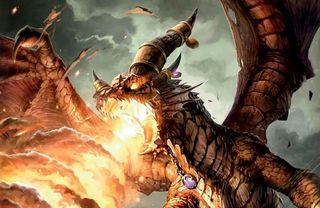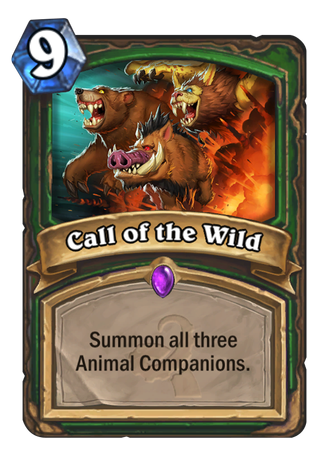How to use data to improve your choice of Hearthstone deck
The way you interpret stats can help your ladder performance.

When it comes to figuring out what deck to play, many Hearthstone players rely on external sources to make their choice. One of the the most popular resources is the Meta Snapshot created by Tempostorm, which relies on a panel of experts to identify the most powerful decks. You can also use Vicious Syndicate’s more data-driven Data Reaper reports, which draw on tens of thousands of games logged by Track-o-Bot to create a picture of what the ladder looks like, and which deck is favoured in the popular matchups. Whatever your poison, the goal is the same: to find a deck that has a solid win rate against the current field.
However, the usefulness of data and expert opinion depends on your ability to interpret it. When considering Hearthstone’s meta, we need to know more than just which decks are powerful and how often we’re likely to encounter them. We also need to know why the meta is in its current state. A typical question you might want to ask is “Is this deck performing well because it’s independently strong, or because other people are experimenting and playing non-optimized lists?”
With that in mind, I want to discuss two techniques which will help you minimize misinterpretations when deciding which deck is best for you to play on ladder.
Information advantage

Post-nerf, Molten Giants cost 25 Mana before hero health reductions, making them almost impossible to use for crazy swing turns, and seriously weakening Handlock as a result.
The word “Handlock” will trigger nostalgic memories for many veteran players, and horrifying flashbacks for others. While the archetype is largely a thing of the past—Renolock being the closest equivalent now—the deck used to pose quite the headache. A big part of that was the need to play around Molten Giants, which meant keeping your opponent above 15 life before killing them in a single turn, but the pain actually began much earlier in the game: during the mulligan phase.
Back when this was still an issue, players facing a Warlock opponent would need to seriously think about whether to keep a card like Big Game Hunter in their opening hand. BGH was obviously good against Handlock’s high-attack threats, but it was also very bad against Zoo, the other popular Warlock archetype. Zoo and Handlock were both strong decks independently—in the sense each would have remained strong without the other existing—but when both were operating in the same meta, they gave each other an inadvertent boost.
That happened because the two decks were so different, meaning they required radically cards to counter them. Without any information about what your opponent was playing, beyond the vague notion that if they threw away more cards it meant they were slightly more likely to be Handlock, players were left unable to mulligan correctly—one of the most impactful phases of the game.
The lesson is that when a class contains one or more effective archetypes that require substantially different mulligan strategies to beat, you can leverage that information to your advantage. And the wider the gulf between the archetypes, the greater that class’s advantage becomes.
PC Gamer Newsletter
Sign up to get the best content of the week, and great gaming deals, as picked by the editors.

is a psychology researcher and avid card game player, with over 20 years of experience in Magic: The Gathering and, more recently, as a consistent legend rank player in Hearthstone. He previously wrote about how to stop evaluating Hearthstone cards wrong and what's wrong with competitive Hearthstone.
I made use of that strategy right after the release of Whispers of the Old Gods. One of the first decks I built was a hyper-aggressive pirate Warrior. Not only was the strategy powerful at a time when people were experimenting with new cards, it was bolstered by the fact that most Warriors were playing control lists at the time. This led to my opponents mulliganing incorrectly, potentially throwing away vital early removal and leaving them unable to counter fast openings. It proved good enough to earn a top 50 finish that month, and a spot at the spring prelims.
Note that this strategy is only as good as the meta allows. If a leftfield strategy posts positive results, that does not necessarily mean the deck itself is independently strong. It might even be quite weak once opponents correctly anticipate it. Eventually, the existence of the deck becomes common knowledge and players plan accordingly, dragging the win rate down to its natural state. As an example of the opposite effect, a recent vS report places Beast Druid in tier 2—despite it largely falling out of favor after the release of One Night in Karazhan due to bad results. But when a deck becomes sufficiently rare, its power level can be temporarily increased to the extent opponents fail to properly anticipate its presence, either by playing decks that match up poorly against it, mulliganing incorrectly, or both.
The power of any deck is partly dependent on other players’ ability to anticipate it. So the number of meaningfully different strategies which a class possesses will alter the power level of all possible decks in that class.

Skill ceilings and floors
If you’re trying to measure how strong a group of people are (with the promise of paid rewards), one option is to put them in a room with a five pound weight and see who can lift it. This isn’t a good test because the chances are you’d end up paying everyone as the task is too easy. We say these people are operating at the “ceiling”, because their performance can’t improve. Similarly, if you repeated the experiment but with a 350 pound weight, you’d find the opposite pattern. Almost no one would be able to lift it, and your group would be operating at the “floor” because their performance can’t get any lower. At least you don’t have to pay them.
This same concept can be applied to understanding the win rates of decks. Before the arrival of standard, Secret Paladin dominated the ladder. In fact, the deck was so strong that even bots—AI designed to farm gold for wins—were able to reach Legend rank. However, it wasn’t just the strength of the deck that made it post good results, it was also the fact that the deck was incredibly easy to play. Secret Paladin didn’t require much in the way of complex decision-making and rewarded weak players with better results than they might otherwise expect.
Many salty players called the deck brainless; to put it more politely, the skill ceiling was certainly low.
The converse is that there was never really anyone known for being a Secret Paladin expert. Few pros were able to push the win rate of the deck far beyond what the average player achieved because, again, there just weren’t that many impactful decisions to make. As a result, there wasn’t huge potential for improvement. Many salty players called the deck brainless; to put it more politely, the skill ceiling was certainly low.
Then there are the decks like Miracle Rogue and Freeze Mage. These require above average amounts of planning and have crucial decision turns. Without sufficient experience piloting the deck and a deep understanding of how different matches will play out, a Freeze Mage will make a series of sub-optimal plays and leave their win rate in the dumpster. However, once well-versed in the deck and its matchups, their win rate will rise dramatically.
To put that into perspective, the same vS data report mentioned earlier has Freeze Mage sitting at an estimated 45% win rate in tier 4, which is really bad. Despite that data-driven estimation, Tempostorm places the deck in tier 2, and Freeze Mage experts like Laughing are able to post results that exceed the average expected matchup win rates by double digits (recently by about 30%, even if 15-20% better is probably closer to his average. A healthy portion of Laughing’s recent win rate came thanks to midrange Shaman, a matchup vS estimates should be 55-57% Freeze favored, but which laughing beats around 75-90% of the time).

After the Mana increase to Call of the Wild, Midrange Hunter players had to think hard about including two copies. Well, slightly harder.
The same point can also be made regarding how decks are built. Some decks—like the current Midrange Shaman—don’t have too many flex spots. You don’t see much variance in the way the deck is built, with most lists not varying by more than two or three cards. Other established decks, however, regularly vary by around five or six cards, which adds an extra layer to the decision making required. These more complex decks will often have card options that do meaningfully different things because their strategies are based around the interactions between cards, whereas more simple decks tend to focus on the raw power of cards in isolation.
Which is why I’ve seen Miracle Rogue lists that I really disliked, but haven’t seen many Midrange Shaman or Secret Paladin lists that gave me the same feeling. Perhaps those specific tradeoffs in Rogue lists aren’t as significant in reality as they feel to me, but we know that even a single card change can make or break a deck. Just ask Midrange Hunter after the recent nerf to Call of the Wild.
The important thing is getting to know your data. Someone who doesn’t understand why a deck has a particular win rate is unlikely to assess its potential accurately. This leads to people relying too heavily on the overall average results of a deck, without considering other contextual data or the importance of outliers. Anecdotal evidence might seem insignificant in the face of big data, but understanding the impact of specific scenarios can lead to an overall improvement in your ladder performance. And remember: it might be pirates.
Most Popular

